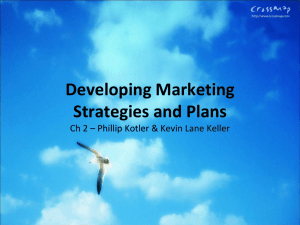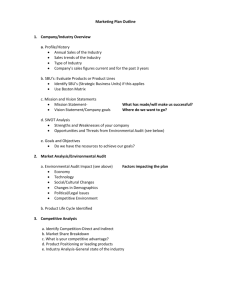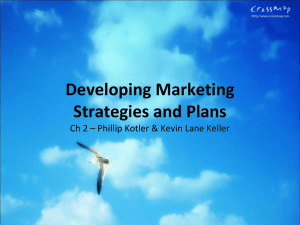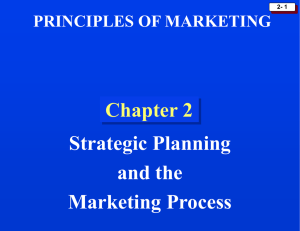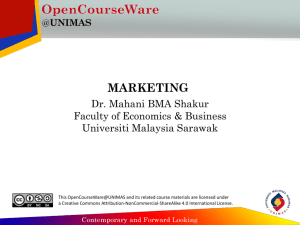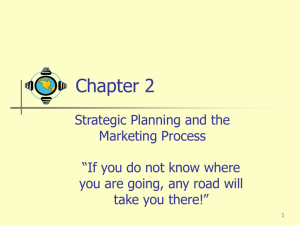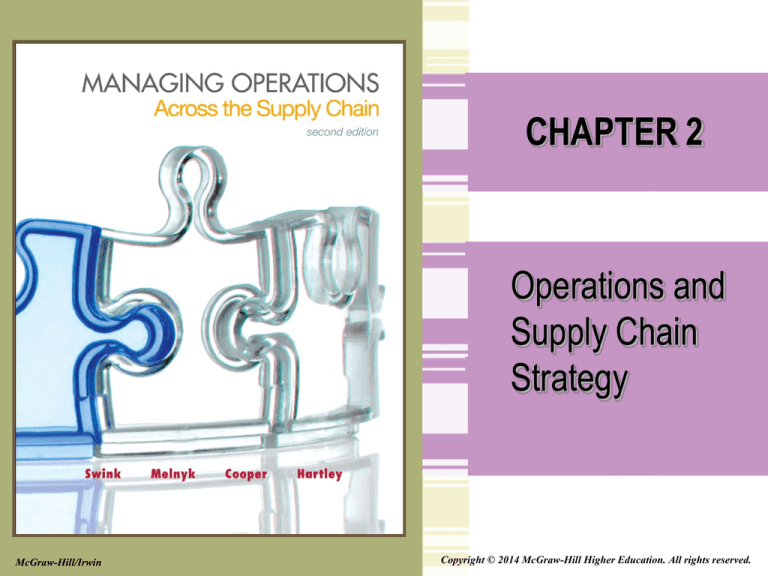
CHAPTER 2
Operations and
Supply Chain
Strategy
McGraw-Hill/Irwin
Copyright © 2014 McGraw-Hill Higher Education. All rights reserved.
Learning Objectives
LO2-1 Describe link between operations and
strategic planning
LO2-2 Describe the links between the essential
elements of operations strategy
LO2-3 Describe customer desired outcomes
LO2-4 Explain product- and process- priorities and
links to competitive advantage
LO2-5 Explain the use of various performance
metrics
2–2
Strategic Planning:
Operations Strategy Defined
Operations Strategy:
A set of competitive priorities coupled with
supply chain structural and infrastructural
design choices intended to create
capabilities that support a set of value
propositions targeted to address the needs
of critical customers
LO2-1
2–3
Levels of Strategic Planning
Environment
Corporate Culture
Strategic Questions
What business(es)
should we be in?
Corporate Strategy
How do we
compete?
Business Strategies
SBU
SBU
SBU
Operations Strategy
How do we best
support the SBU
strategy?
• Structure
• Infrastructure
Finance, Marketing, etc. Strategies
LO2-2
Figure 2-1
2–4
Levels of Strategic Planning:
Corporate Strategy
Corporate Strategy: overall mission and target
businesses
• Long time horizon
• Overall values, direction and goals
• Acquisitions and divestitures
• Performance metrics
• Risk management
LO2-2
2–5
Levels of Strategic Planning:
Strategic Business Unit
Strategic Business Unit (SBU): semiindependent organization for different products or
markets
• Identification of customer or market segments
• Appropriate competitive priorities
• Constrained by corporate strategy
• More detailed
• Shorter time horizon
LO2-2
2–6
Levels of Strategic Planning:
Functional Strategy
Functional strategy: determines how functions
support business unit strategies
• Management of critical resources
• Key metrics
• Identification of capabilities
• Coordination of activities
LO2-2
2–7
Developing an Operations Strategy
• Critical Customer: critical to firm’s success and
receives firm’s focus
• Value Proposition: tangible and intangibles that
customers expect from a firm
• Capabilities: what a firm
does well, defines types
of problems a firm can
proficiently address
LO2-3
Figure 2-2
2–8
Product-Related Competitive
Priorities
How customer’s problem is ‘solved’
•Quality: fitness for consumption in terms of
meeting customer needs & desires
•Timeliness: delivery or availability when
customer wants
•Cost: expenses incurred is acquiring or
using the product
LO2-4
2–9
Competitive Priorities: Quality
Quality: How ‘fit’ is your product
according to your customers needs?
• Performance
• Aesthetics
• Features
• Service/support
• Conformance
• Perceived
quality
• Reliability
• Durability
LO2-4
2–10
Competitive Priorities:
Timeliness
Timeliness: Is your product delivered
to your customers when they want it?
• Reliability
• Speed
• Availability
LO2-4
2–11
Competitive Priorities: Cost
Cost: How much does it cost to
acquire and use your product?
• Purchase
• Transaction
• Maintenance/repair
• Operating
• Salvage/disposal
LO2-4
2–12
Capabilities Defined
• Capabilities: unique and superior abilities
based upon the firm’s routines, skills and
processes
• Key areas for capability-building investment and
development efforts:
–Processes
–Planning systems
–Technology
–People and culture
–Supply chain relations
LO2-4
2–13
Strategic Areas in Operations
Management: Structure
Decision
Domain
OM Issues
Considered
Other Functional
Groups
Capacity
Amount, timing and
type
Finance, Marketing
Facilities
Size, location,
specialization
Finance, Marketing
Technology
Hardware, software, IS
Finance, Engineering, IT,
HR
Supply Chain
Network
Supply network
Customer network
Finance, Engineering,
Marketing, Sales
From Table 2-3
LO2-4
2–14
Strategic Areas in Operations
Management: Infrastructure
Decision
Domain
OM Issues
Considered
Other Functional
Groups
Workforce
Skills, training, policies,
etc.
Human Resources
Production
Planning and
Control
Procedures, workflow,
costs, controls, metrics,
etc.
Finance, Human
Resources
Product/Process
Innovation
Improvements, NPI,
intellectual property, etc.
Engineering, Human
Resources
Organization &
Management
Centralization, hierarchy,
relationships, metrics,
etc.
Human Resources,
Marketing
From Table 2-3
LO2-4
2–15
Strategic Profit Model
LO2-5
2–16
OM and SC Strategy Summary
1. Strategic planning happens at multiple levels
2. Strategic planning begins with the customer
3. OM strategy brings together: critical customers, value
propositions and operations capabilities
4. Competitive priorities address product and process issues
5. Future capabilities depend on existing core competencies
6. Strategy involves multiple functions and SC partners
7. Must be fit between the elements of #3 above
8. Strategic assessment tools are needed
2–17


